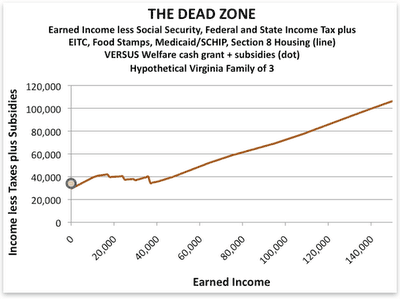Dan Lakeland has been thinking about taxation curves and the poverty trap.
The short story goes as follows: a graduated tax rate reduces the incentive to increase your income. At the high end, this is probably fine: do we really care if Tiger Woods or Bill Gates makes more money? Really it would be fine if they were to follow the example of Greg Mankiw and reduce their working hours and spend more time with their kids. As he wrote:
The bottom line: If you are one of those people out there trying to induce me [Mankiw] to do some work for you, there is a good chance I will turn you down. And the likelihood will go up after President Obama puts his tax plan in place. I expect to spend more time playing with my kids. They will be poorer when they grow up, but perhaps they will have a few more happy memories.
But at the low end, maybe it’s more of a problem if people have little economic motivation to increase their income. Mankiw displayed this graph:

This picture doesn’t tell the whole story. Despite the flat curve, you’re probably better off making $40,000 then $20,000; for one thing, if you’re at the $40,000 point, it seems like you have a chance to go from there into that happy upward-sloping range.
But, setting practical concerns aside for a moment, Lakeland plays around with some mathematical models of the curves. Perhaps could be useful to some economist somewhere, so I’m linking here and here. Enjoy.
- Bulenox: Get 45% to 91% OFF ... Use Discount Code: UNO
- Risk Our Money Not Yours | Get 50% to 90% OFF ... Use Discount Code: MMBVBKSM
Disclaimer: This page contains affiliate links. If you choose to make a purchase after clicking a link, we may receive a commission at no additional cost to you. Thank you for your support!




Leave a Reply